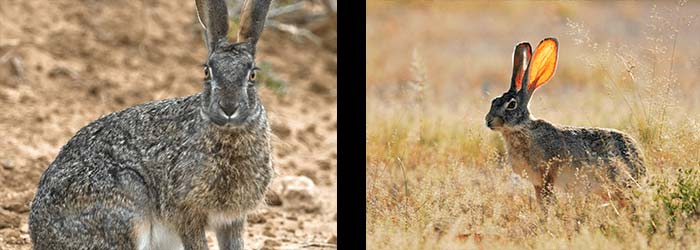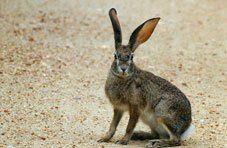The Scrub Hare is endemic to southern Africa and it can be found pretty much everywhere, except for the Namib Desert. As you'd expect, their preferred habitat is scrub, tall grasslands and savanna woodlands. You will recognise them by grey fur with small black spots which is covering their backs, and white bellies. They’ve got small, black and white, stubby tails and patches of red-brown fur behind the long ears. Same as with Cape Hare, females are normally larger than the males.
Scrub Hare is not a particularly social animal and you're likely to see girls and boys together only when mating. The little mammal is active during the night, which is when it goes out to look for food, the preferred choice being green grass. It's difficult to spot them at daylight because they'll bury themselves into the ground, tuck their ears back to their shoulders and lie motionless. This is also a form of protection, as their colour blends extremely well with the scrubland, making them difficult to spot by the predators.

When a female is in heat, a number of the males will hang around hoping to mate with her. As is typical in many other species, guys will fight each other to win the girl over. In this case, they will box using their forefeet or kick with their back legs. The competition is so fierce that sometimes even the girl gets injured. Their offspring is born with open eyes, fully haired and are basically capable of taking care of themselves, which is why mums will invest little time in parenting them. While Scrub Hare can survive about 5 years in the wild, many of them don't make it through their first year.
One reason is surely the predators, such as side-striped jackal, cheetah, predatory birds and caracal. Scrub Hare is pretty much powerless when it comes to fighting such enemies off, the best chance to survive given by the colouring of its fur which offers a camouflage against the surrounding terrain. So if a predator comes near, the hare will remain motionless for as long as possible, and then jump up and run for safety as fast as it can in a zig zag formation. If it fails and gets caught, Scrub Hare will produce a loud squeal and try to kick and bite his enemy, usually with little success.
Unfortunately, this is yet another species endangered through the actions of us humans, such as hunting them for food and using their soft fur to make gloves. Farming and urban development causes the loss of habitat and leaves the Scrub Hare exposed to its predators. Despite all that, this species is not regarded as threatened and their conservation status is considered to be lower risk. For now.




